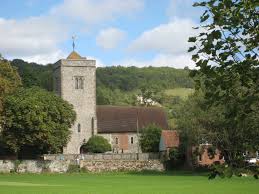Address:
Trottiscliffe, West Malling ME19 5EE
Map: https://goo.gl/maps/QDzDJ9LAwXNUn3Sv5
Parking
There are two small areas set aside for car parking nearby.
History
The name Trottiscliffe was taken from Trodesclif,
meaning a hilly tract close to the foot of chalk hills. Travellers would
cross the higher ground along the Pilgrims’ Way into the lower woods to
stop for shelter and rest. The old track across the escarpment still forms part
of the parish boundary.
In the years after the Norman conquest, the manor
of Trottiscliffe was endowed to Bishop Gundulf of Rochester who used its
produce to support his table. Perhaps in the spirit of this connection the pots
of locally-made jam on sale in the church are decorated with Gundulf’s image!
For a small village church, the fittings are rather
splendid with a richly carved oak reredos and 18th century box
pews. Perhaps most remarkable is the pulpit which was originally in
Westminster Abbey having been designed by Henry Keene in 1778. It was given to
Trottiscliffe Church in 1824 after it had been removed from the Abbey for the
coronation of George IV in 1820. The Dean and Chapter of the Abbey were not
party to this gift and were not at all happy that it had been given away.
Happily for Trottiscliffe they were not able to recover the pulpit. The richly
carved pulpit was recently featured in Country Life.
One of the box pews was originally used by the
church singers in the early 19th century and much of their music still survives
in the county archives. The barrel organ which replaced them in the 1860’s
was in use until 1939 – one of the rare survivors of this particular type of
church music. Having lain dismantled in Rochester museum for the best part of
50 years it was recently restored to playing condition but there is not enough
room in the church to display it permanently.
The noted artist Graham Sutherland (1903-1980) lived in Trottiscliffe and is buried in the churchyard. He is remembered for major surviving works such as the large tapestry of Christ in Coventry Cathedral and for one lost work – a portrait of Winston Churchill that was destroyed by the statesman’s wife, Clementine.


